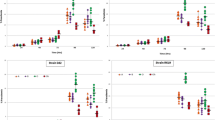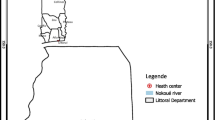Abstract
Repeated incubation of Plasmodium falciparum culture in 0.015 % saponin solution for a total of 35 min destroys most of the uninfected cells, leaving only the ring-infected erythrocytes (RIEs). Parasites concentrated by this method can subsequently complete the asexual cycle and infect other erythrocytes. It is possible that resistance to saponin is mediated by one or more of the numerous parasite proteins present in the host erythrocyte membrane. We have found that schizonts are as susceptible as uninfected erythrocytes to saponin, indicating that the protective protein is parasite stage specific. Studies with cultured parasites have shown that ring-infected erythrocyte surface antigen (RESA) strengthens host erythrocyte membrane and protects against destruction. Therefore, we hypothesize that RESA could be involved in resistance to saponin. Here, we have carried out PCR test on RESA gene, using three different primers. One of them showed that P. falciparum isolates collected directly from infected humans and cultured only for a few days, or not at all, have amplicon sizes ranging from 372 to 510 bp. However, the amplicon size changed to 873 bp when in vitro growth was continued for one or more weeks. This genetic transformation precedes acquisition of the ability to confer saponin resistance to RIEs.






Similar content being viewed by others
References
Aikawa M, Torii M, Sjolander A, Berzins K, Perlmann P, Miller LH (1990) Pf155/RESA antigen is localized in dense granules of Plasmodium falciparum merozoites. Exp Parasitol 71:326–329
Alfadhli S, Salim M, Al-Awadi S (2004) A novel germ line mutation in the von Hippel-Lindau gene in patients in Kuwait. Med Princ Pract 13:312–315
Angus BJ, Chotivanich K, Udomsangpetch R, White NJ (1997) In vivo removal of malaria parasites from red blood cells without their destruction in acute falciparum malaria. Blood 90:2037–2040
Bangham AD, Horne RW (1962) Action of saponin on biological membranes. Nature 196:952–953
Biggs BA, Kemp DJ, Brown GV (1989) Subtelomeric chromosome deletions in field isolates of Plasmodium falciparum and their relationship to loss of cytoadherence in vitro. Proc Natl Acad Sci U S A 86:2428–2432
Bottger S, Hofman K, Melzig MF (2012) Saponins can perturb biologic membranes and reduce the surface tension of aqueous solutions: a correlation? Bioorg Med Chem 20:2822–2828
Bottius E, Bakhsis N, Scherf A (1998) Plasmodium falciparum telomerase: de novo telomere addition to telomeric and nontelomeric sequences and role in chromosome healing. Mol Cell Biol 18:919–925
Cooke BM, Lingelbach K, Bannister L, Tilley L (2004) Protein trafficking in Plasmodium falciparum-infected red blood cells. Trends Parasitol 20:581–589
Deitsch KW, Wellems TE (1996) Membrane modifications in erythrocytes parasitized by Plasmodium falciparum. Mol Biochem Parasitol 76:1–10
Deloron P, Duverseau YT, Zevallos-Ipenza A, Magloire R, Stanfill PS, Nguyen-Dinh P (1987) Antibodies to Pf155, a major antigen of Plasmodium falciparum: seroepidemiological studies in Haiti. Bull World Health Organ 65:339–344
Diez-Silva M, Cooke BM, Guillotte M, Buckingham DW, Sauzet J-P, Scanf CL, Contamin H, David P, Mercereau-Puijalon O, Bonnefoy S (2005) A role for the Plasmodium falciparum RESA protein in resistance against heat shock demonstrated using gene disruption. Mol Microbiol 56:990–1003
Favaloro JM, Coppel RL, Corcoran LM, Foote SJ, Brown GV, Anders RF, Kemp DJ (1986) Structure of the RESA gene of Plasmodium falciparum. Nucleic Acids Res 14:8265–8277
Genton B, Al-Yaman F, Betuela I, Anders RF, Saul A, Baea K, Mellombo M, Taraika U, Brown GV, Pye D, Irving DO, Felger I, Beck H-P, Smith TA, Alpers MP (2003) Safety and immunogenicity of a three-component blood-stage malaria vaccine (MSP1, MSP2, RESA) against Plasmodium falciparum in Papua New Guinean children. Vaccine 22:30–41
Goldberg DE, Cowman AF (2010) Moving in and renovating: exporting proteins from Plasmodium into host erythrocytes. Nat Rev Microbiol 8:617–621
Haldar K, Mohandas N (2007) Erythrocyte remodeling by malaria parasites. Curr Opin Hematol 14:203–209
Hernandez-Rivas R, Hinterberg K, Scherf A (1996) Compartmentalization of genes coding for immunodominant antigens to fragile chromosome ends leads to dispersed subtelomeric gene families and rapid gene evolution in Plasmodium falciparum. Mol Biochem Parasitol 78:137–148
Kabilan L, Sharma VP, Kaur P, Ghosh SK, Yadav RS, Chauhan VS (1994) Cellular and humoral immune responses to well-defined blood stage antigens (major merozoite surface antigen) of Plasmodium falciparum in adults from an Indian zone where malaria is endemic. Infect Immun 62:685–691
Maier AG, Cooke BM, Cowman AF, Tilley L (2009) Malaria parasite proteins that remodel host erythrocyte. Nat Rev Microbiol 7:341–354
Mills JP, Diez-Silva M, Quinn DJ, Dao M, Lang MJ, Tan KSW, Lim CT, Milon G, David PH, Mercereau-Puijalon O, Bonnefoy S, Suresh S (2007) Effect of plasmodial RESA protein on deformability of human red blood cells harboring Plasmodium falciparum. Proc Natl Acad Sci U S A 104:9213–9217
Moorthy VS, Good MF, Hill AVS (2004) Malaria vaccine developments. Lancet 363:150–156
Moyano EM, Gonzalez LM, Cuevas L, Perez-Pastrana E, Santa-Maria Y, Benito A (2001) Molecular cloning and characterization of the RESA gene, a marker of genetic diversity of Plasmodium falciparum. Mol Biol Rep 37:2893–2902
Orjih AU (2012) Hemozoin accumulation in Garnham bodies of Plasmodium falciparum gametocytes. Parasitol Res 111:2353–2359
Orjih AU (2008) Requirements for maximal enrichment of viable intraerythrocytic Plasmodium falciparum rings by saponin hemolysis. Exp Biol Med 233:1359–1367
Orjih AU (1996) Hemolysis of Plasmodium falciparum trophozoite-infected erythrocytes after artemisinin exposure. Br J Haematol 92:324–328
Orjih AU (1994) Saponin haemolysis for increasing concentration of Plasmodium falciparum infected erythrocytes. Lancet 343:295
Pei X, Guo X, Coppel R, Bhattacharjee S, Haldar K, Gratzer W, Mohandas N, An X (2007) The ring-infected erythrocyte surface antigen (RESA) of Plasmodium falciparum stabilizes spectrin tetramers and suppresses further invasion. Blood 110:1036–1042
Ribacke U, Mok BW, Wirta V, Normark J, Lundeberg J, Kironde F, Egwang TG, Nilsson P, Wahlgren M (2007) Genome wide gene amplifications and deletions in Plasmodium falciparum. Mol Biochem Parasitol 155:33–44
Scherf A, Mattei D (1992) Cloning and characterization of chromosome breakpoints of Plasmodium falciparum: breakage and new telomere formation occurs frequently and randomly in subtelomeric genes. Nucleic Acids Res 20:1491–1496
Vazeux G, Le Scanf C, Fandeur T (1993) The RESA-2 gene of Plasmodium falciparum is transcribed in several independent isolates. Infect Immun 61:4469–4472
Wooden J, Kyes S, Sibley CH (1993) PCR and strain identification in Plasmodium falciparum. Parasitol Today 9:303–305
Acknowledgment
This work was supported by Kuwait University Research Grant No. NM02/05. We thank Dr. SM Alfadhli and Prof. YA Luqmani for their assistance in interpreting RESA sequence.
Author information
Authors and Affiliations
Corresponding author
Rights and permissions
About this article
Cite this article
Orjih, A.U., Cherian, P.T. Possible relationship between Plasmodium falciparum ring-infected erythrocyte surface antigen (RESA) and host cell resistance to destruction by chemicals. Parasitol Res 112, 4043–4051 (2013). https://doi.org/10.1007/s00436-013-3595-9
Received:
Accepted:
Published:
Issue Date:
DOI: https://doi.org/10.1007/s00436-013-3595-9




